আপনি বাজার সংগ্রাহক আপগ্রেড শেখান ব্যাকটেস্ট কাস্টম তথ্য উৎস
লেখক:ভাল, তৈরিঃ 2020-06-06 08:53:02, আপডেটঃ 2023-11-01 20:28:58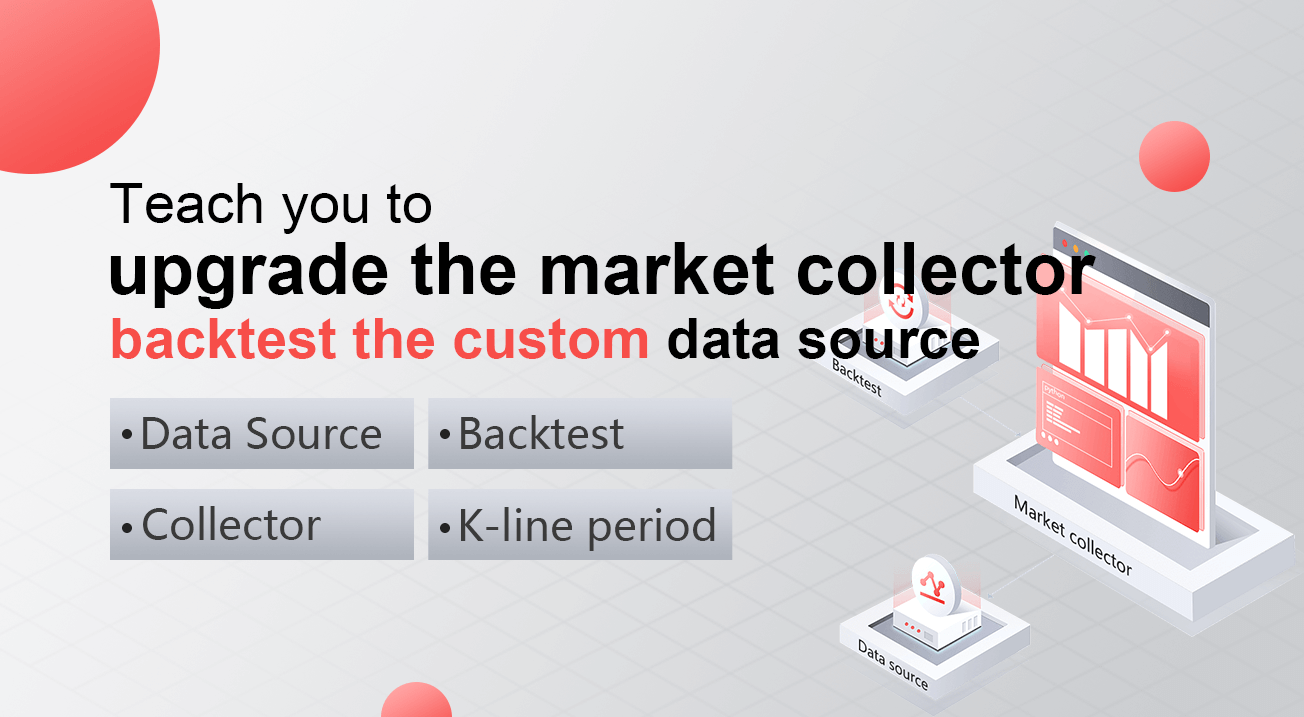
পূর্ববর্তী নিবন্ধআপনাকে শেখান কিভাবে একটি বাজার কোট সংগ্রহকারী বাস্তবায়নআমরা একটি রোবট প্রোগ্রাম বাস্তবায়ন করেছি যা একসাথে বাজার কোট সংগ্রহ করে।
আমরা এটি সংগ্রহ করার পরে কীভাবে বাজারের ডেটা ব্যবহার করব? এটি ব্যাকটেস্ট সিস্টেমের জন্য ব্যবহার করা হবে। এফএমজেড প্ল্যাটফর্ম ব্যাকটেস্ট সিস্টেমের কাস্টম ডেটা উত্স ফাংশনের উপর নির্ভর করে, আমরা সংগৃহীত ডেটা সরাসরি ব্যাকটেস্ট সিস্টেমের ডেটা উত্স হিসাবে ব্যবহার করতে পারি, যাতে আমরা ব্যাকটেস্ট সিস্টেমকে যে কোনও বাজারে ব্যবহার করতে পারি যেখানে আমরা ঐতিহাসিক ডেটা ব্যাকটেস্ট করতে চাই।
সুতরাং, আমরা
প্রস্তুত হও
এটি পূর্ববর্তী নিবন্ধের প্রস্তুতির কাজ থেকে আলাদা। শেষবার আমার স্থানীয় ম্যাক কম্পিউটারে একটি ডকার প্রোগ্রাম চলছে, ডাটাবেস পরিষেবা শুরু করতে মঙ্গোডব ডাটাবেস ইনস্টল করা। এই সময় আমরা অপারেটিং পরিবেশটি ভিপিএসে পরিবর্তন করেছি এবং আমাদের প্রোগ্রামগুলির সেট চালানোর জন্য আলিবাবা ক্লাউড লিনাক্স সার্ভার ব্যবহার করেছি।
- Mongodb ডাটাবেজ
পূর্ববর্তী নিবন্ধের মত, আমাদের মঙ্গোডব ডাটাবেস ইনস্টল করতে হবে ডিভাইসে যেখানে মার্কেট কালেক্টর প্রোগ্রাম চলছে এবং পরিষেবাটি শুরু করতে হবে। এটি মূলত ম্যাক কম্পিউটারে মঙ্গোডব ইনস্টল করার মতোই। ইন্টারনেটে অনেক টিউটোরিয়াল রয়েছে, আপনি এটি গুগল করতে পারেন, এটি খুব সহজ।
- পাইথন 3 ইনস্টল করুন
প্রোগ্রামটি পাইথন 3 ব্যবহার করে, কিছু পাইথন লাইব্রেরি ব্যবহারের দিকে মনোযোগ দিন, যদি তারা ইনস্টল না হয়, তাহলে আপনাকে প্রথমে তাদের ইনস্টল করতে হবে।
পিমঙ্গো http উর্লিব
- ডকার
এফএমজেড ডকিং যথেষ্ট হবে।
মার্কেট কোট কালেক্টরকে রূপান্তর করুন
বাজার কোট সংগ্রহকারী এই হলঃhttps://www.fmz.com/strategy/199120(RecordsCollector) কৌশল.
এর কিছু পরিবর্তন করা যাক:
তথ্য সংগ্রহের জন্য প্রোগ্রামটি যখন লুপে প্রবেশ করে, তখন একটি মাল্টি-থ্রেডেড লাইব্রেরি ব্যবহার করা হয় এবং একই সাথে এক্সিকিউশনটি এফএমজেড প্ল্যাটফর্ম ব্যাকটেস্ট সিস্টেমের ডেটা অনুরোধ পর্যবেক্ষণের জন্য একটি পরিষেবা শুরু করে। (অন্যান্য বিবরণ উপেক্ষা করা যেতে পারে)
RecordsCollector (কস্টম ডেটা উৎস ফাংশন প্রদানের জন্য আপগ্রেড)
import _thread
import pymongo
import json
import math
from http.server import HTTPServer, BaseHTTPRequestHandler
from urllib.parse import parse_qs, urlparse
def url2Dict(url):
query = urlparse(url).query
params = parse_qs(query)
result = {key: params[key][0] for key in params}
return result
class Provider(BaseHTTPRequestHandler):
def do_GET(self):
try:
self.send_response(200)
self.send_header("Content-type", "application/json")
self.end_headers()
dictParam = url2Dict(self.path)
Log("The custom data source service receives the request, self.path:", self.path, "query parameter:", dictParam)
# At present, the backtesting system can only select the exchange name from the list. When adding a custom data source, set it to Binance, that is: Binance
exName = exchange.GetName()
# Note that period is the bottom K-line period
tabName = "%s_%s" % ("records", int(int(dictParam["period"]) / 1000))
priceRatio = math.pow(10, int(dictParam["round"]))
amountRatio = math.pow(10, int(dictParam["vround"]))
fromTS = int(dictParam["from"]) * int(1000)
toTS = int(dictParam["to"]) * int(1000)
# Connect to the database
Log("Connect to the database service to obtain data, the database:", exName, "table:", tabName)
myDBClient = pymongo.MongoClient("mongodb://localhost:27017")
ex_DB = myDBClient[exName]
exRecords = ex_DB[tabName]
# Request data
data = {
"schema" : ["time", "open", "high", "low", "close", "vol"],
"data" : []
}
# Construct query condition: greater than a certain value{'age': {'$gt': 20}} Less than a certain value{'age': {'$lt': 20}}
dbQuery = {"$and":[{'Time': {'$gt': fromTS}}, {'Time': {'$lt': toTS}}]}
Log("Query conditions:", dbQuery, "Number of inquiries:", exRecords.find(dbQuery).count(), "Total number of databases:", exRecords.find().count())
for x in exRecords.find(dbQuery).sort("Time"):
# Need to process data accuracy according to request parameters round and vround
bar = [x["Time"], int(x["Open"] * priceRatio), int(x["High"] * priceRatio), int(x["Low"] * priceRatio), int(x["Close"] * priceRatio), int(x["Volume"] * amountRatio)]
data["data"].append(bar)
Log("data:", data, "Respond to backtest system requests.")
# Write data reply
self.wfile.write(json.dumps(data).encode())
except BaseException as e:
Log("Provider do_GET error, e:", e)
def createServer(host):
try:
server = HTTPServer(host, Provider)
Log("Starting server, listen at: %s:%s" % host)
server.serve_forever()
except BaseException as e:
Log("createServer error, e:", e)
raise Exception("stop")
def main():
LogReset(1)
exName = exchange.GetName()
period = exchange.GetPeriod()
Log("collect", exName, "Exchange K-line data,", "K line cycle:", period, "second")
# Connect to the database service, service address mongodb://127.0.0.1:27017 See the settings of mongodb installed on the server
Log("Connect to the mongodb service of the hosting device, mongodb://localhost:27017")
myDBClient = pymongo.MongoClient("mongodb://localhost:27017")
# Create a database
ex_DB = myDBClient[exName]
# Print the current database table
collist = ex_DB.list_collection_names()
Log("mongodb ", exName, " collist:", collist)
# Check if the table is deleted
arrDropNames = json.loads(dropNames)
if isinstance(arrDropNames, list):
for i in range(len(arrDropNames)):
dropName = arrDropNames[i]
if isinstance(dropName, str):
if not dropName in collist:
continue
tab = ex_DB[dropName]
Log("dropName:", dropName, "delete:", dropName)
ret = tab.drop()
collist = ex_DB.list_collection_names()
if dropName in collist:
Log(dropName, "failed to delete")
else :
Log(dropName, "successfully deleted")
# Start a thread to provide a custom data source service
try:
# _thread.start_new_thread(createServer, (("localhost", 9090), )) # local computer test
_thread.start_new_thread(createServer, (("0.0.0.0", 9090), )) # Test on VPS server
Log("Open the custom data source service thread", "#FF0000")
except BaseException as e:
Log("Failed to start the custom data source service!")
Log("Error message:", e)
raise Exception("stop")
# Create the records table
ex_DB_Records = ex_DB["%s_%d" % ("records", period)]
Log("Start collecting", exName, "K-line data", "cycle:", period, "Open (create) the database table:", "%s_%d" % ("records", period), "#FF0000")
preBarTime = 0
index = 1
while True:
r = _C(exchange.GetRecords)
if len(r) < 2:
Sleep(1000)
continue
if preBarTime == 0:
# Write all BAR data for the first time
for i in range(len(r) - 1):
bar = r[i]
# Write line by line, you need to determine whether the data already exists in the current database table, based on timestamp detection, if there is the data, then skip, if not write in
retQuery = ex_DB_Records.find({"Time": bar["Time"]})
if retQuery.count() > 0:
continue
# Write bar to the database table
ex_DB_Records.insert_one({"High": bar["High"], "Low": bar["Low"], "Open": bar["Open"], "Close": bar["Close"], "Time": bar["Time"], "Volume": bar["Volume"]})
index += 1
preBarTime = r[-1]["Time"]
elif preBarTime != r[-1]["Time"]:
bar = r[-2]
# Check before writing data, whether the data already exists, based on time stamp detection
retQuery = ex_DB_Records.find({"Time": bar["Time"]})
if retQuery.count() > 0:
continue
ex_DB_Records.insert_one({"High": bar["High"], "Low": bar["Low"], "Open": bar["Open"], "Close": bar["Close"], "Time": bar["Time"], "Volume": bar["Volume"]})
index += 1
preBarTime = r[-1]["Time"]
LogStatus(_D(), "preBarTime:", preBarTime, "_D(preBarTime):", _D(preBarTime/1000), "index:", index)
# adding drawing display
ext.PlotRecords(r, "%s_%d" % ("records", period))
Sleep(10000)
পরীক্ষা
রোবট কনফিগার করুন
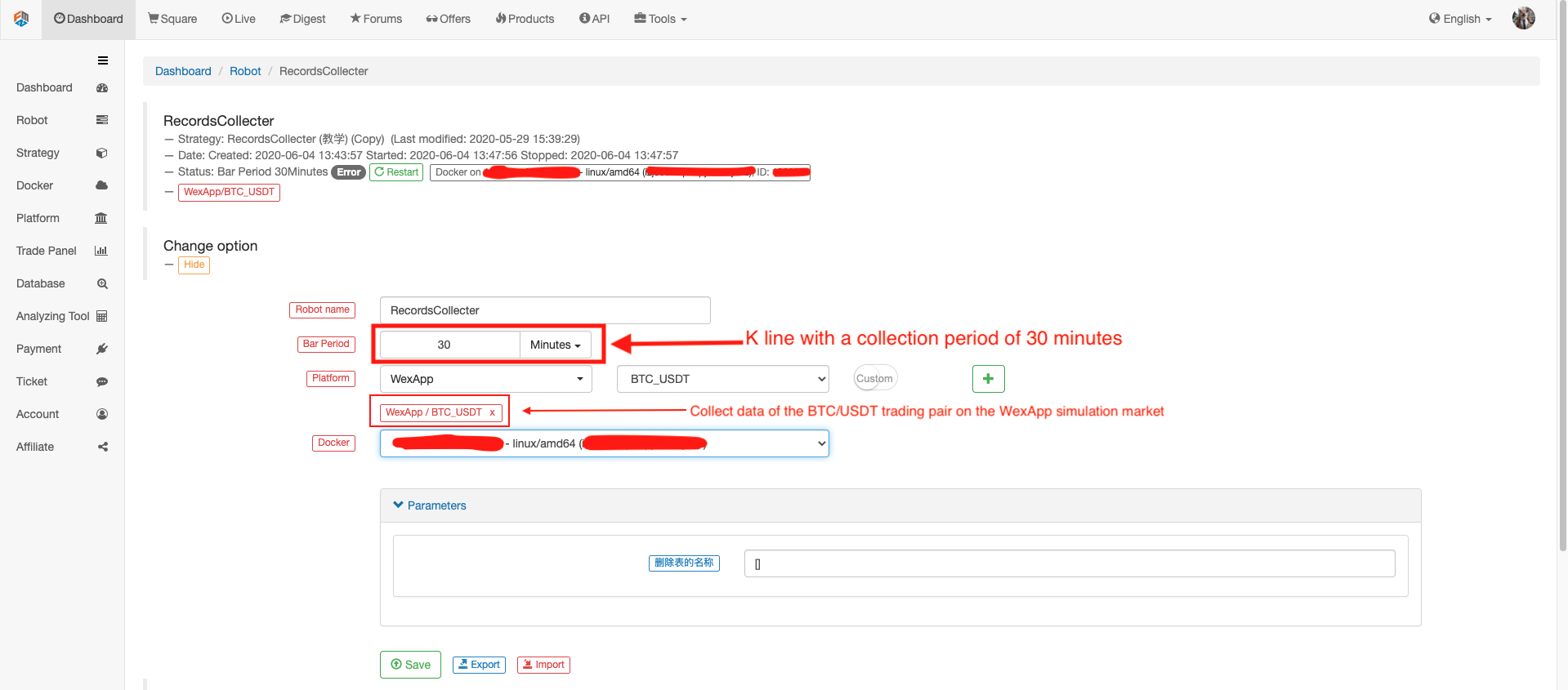
রোবট চালাও, বাজার কোট সংগ্রহকারী চালাও।
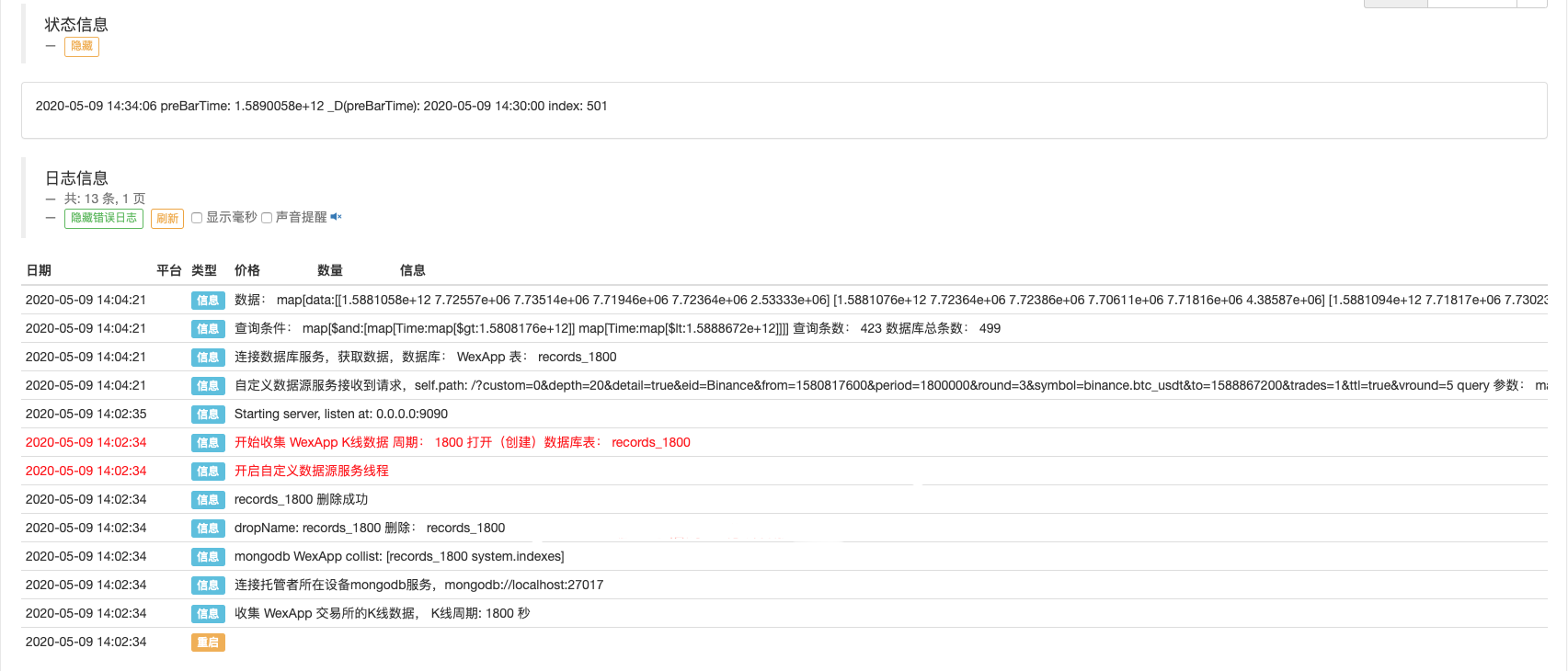
ব্যাকটেস্টের জন্য একটি টেস্ট কৌশল খুলুন। উদাহরণস্বরূপঃ
function main() {
Log(exchange.GetRecords())
Log(exchange.GetRecords())
Log(exchange.GetRecords())
Log(exchange.GetRecords())
Log(exchange.GetRecords())
Log(exchange.GetRecords())
Log(exchange.GetRecords().length)
}
ব্যাকটেস্ট অপশনটি কনফিগার করুন, এক্সচেঞ্জটি বিন্যান্সে সেট করুন কারণ অস্থায়ী কাস্টম ডেটা উত্সটি এখনও নিজের দ্বারা এক্সচেঞ্জের নাম তৈরি করতে পারে না, আপনি কেবল তালিকার এক্সচেঞ্জের কনফিগারেশনগুলির মধ্যে একটি ধার নিতে পারেন, ব্যাকটেস্টটি দেখায় যে বিন্যান্স, প্রকৃত এটি উইক্সঅ্যাপের সিমুলেশন বাজারের ডেটা।

একটি কাস্টম ডেটা উত্স হিসাবে বাজার কোট সংগ্রাহক উপর ভিত্তি করে ব্যাকটেস্ট সিস্টেম দ্বারা উত্পন্ন চার্ট wexApp বিনিময় পৃষ্ঠায় 1 ঘন্টা কে-লাইন চার্ট সঙ্গে একই কিনা তুলনা করুন।
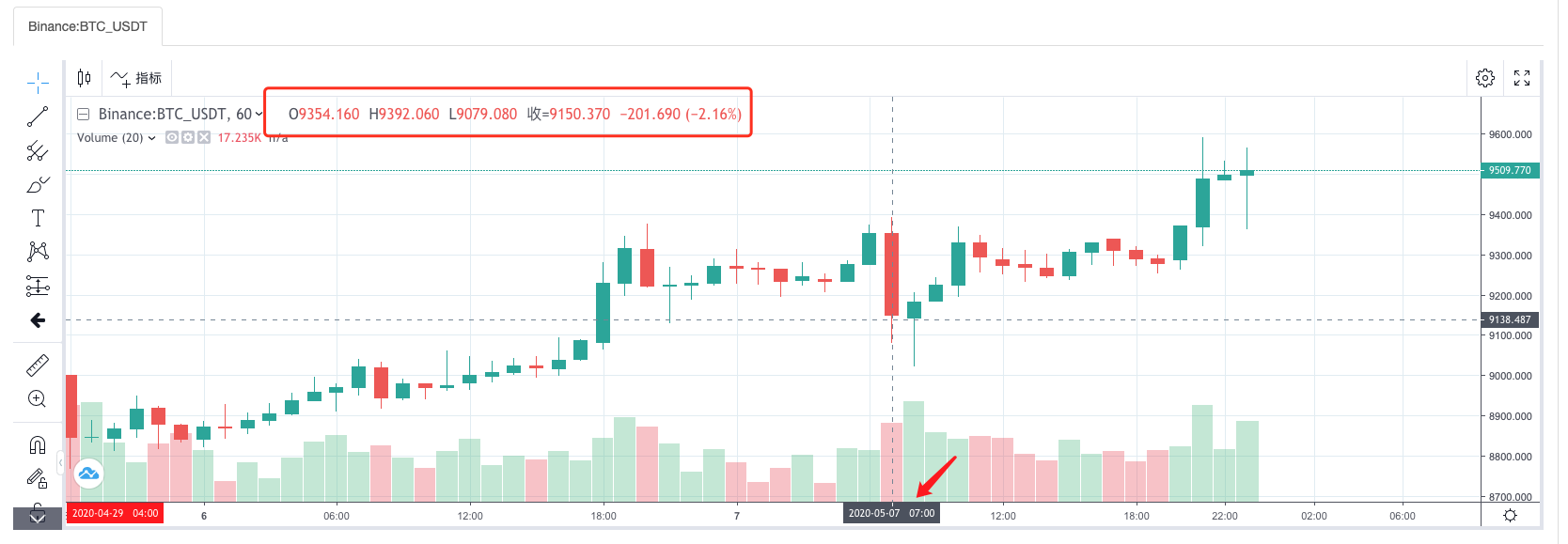
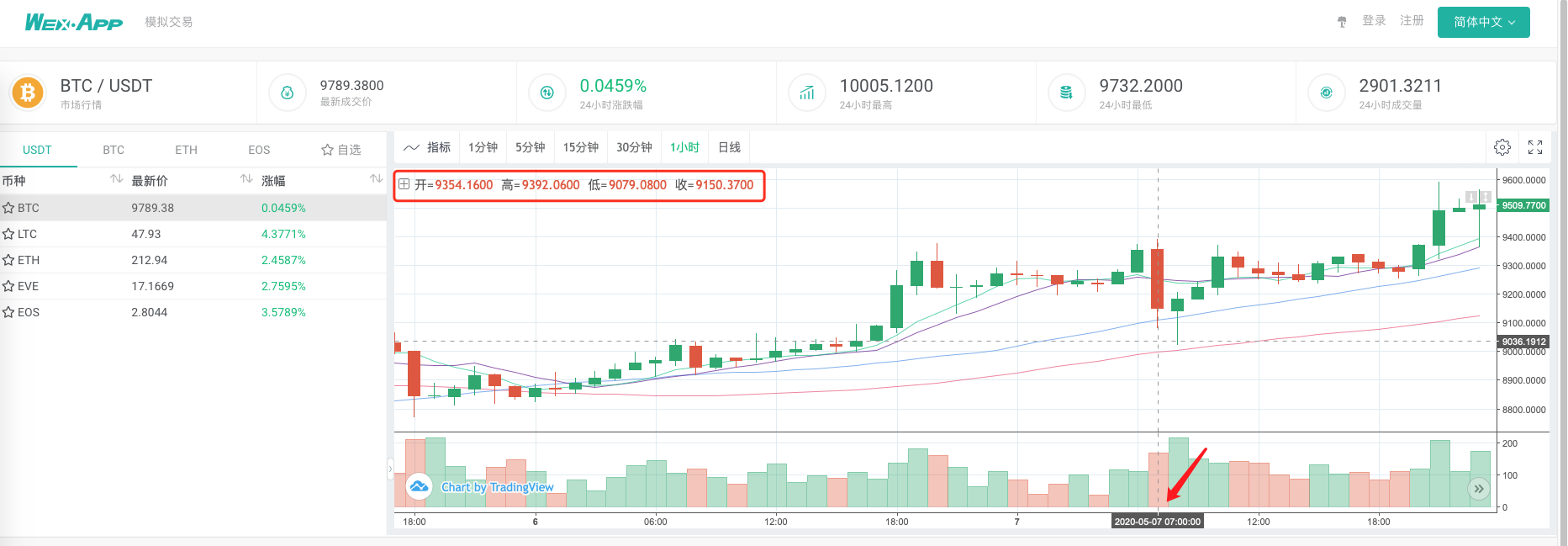
এই ভাবে, ভিপিএসের রোবট নিজেই কে-লাইন ডেটা সংগ্রহ করতে পারে, এবং আমরা যে কোন সময় সংগ্রহ করা ডেটা পেতে পারি এবং সরাসরি ব্যাকটেস্ট সিস্টেমে ব্যাকটেস্ট করতে পারি।
উদাহরণস্বরূপ, আপনি রিয়েল-লেভেল ব্যাকটেস্ট কাস্টম ডেটা উত্স, এবং মাল্টি-বৈচিত্র্য, মাল্টি-মার্কেট ডেটা সংগ্রহ এবং অন্যান্য ফাংশন চেষ্টা করে সম্প্রসারণ চালিয়ে যেতে পারেন।
- ক্রিপ্টোকারেন্সি মার্কেটে মৌলিক বিশ্লেষণের পরিমাণ নির্ধারণঃ তথ্য নিজের জন্য কথা বলতে দিন!
- মুদ্রাচক্রের মৌলিক পরিমাণগত গবেষণা - এখন আর সব ধরনের ধাঁধাবাদী শিক্ষকদের বিশ্বাস করা বন্ধ করুন, তথ্য অবজেক্টিভভাবে কথা বলছে!
- কোয়ালিফাইড লেনদেনের জন্য একটি অপরিহার্য সরঞ্জাম - উদ্ভাবক কোয়ালিফাইড ডেটা এক্সপ্লোরার মডিউল
- সবকিছু আয়ত্ত করা - এফএমজেড ট্রেডিং টার্মিনালের নতুন সংস্করণে ভূমিকা (টিআরবি আর্বিট্রেজ সোর্স কোড সহ)
- এফএমজেডের নতুন ট্রেডিং টার্মিনালের সাথে পরিচিত হোন (ট্র্যাফিক কোড সহ)
- FMZ Quant: ক্রিপ্টোকারেন্সি মার্কেটে সাধারণ প্রয়োজনীয়তা ডিজাইন উদাহরণগুলির বিশ্লেষণ (II)
- কিভাবে 80 লাইন কোডে একটি উচ্চ ফ্রিকোয়েন্সি কৌশল সঙ্গে মস্তিষ্কহীন বিক্রয় বট শোষণ
- এফএমজেড পরিমাণঃ ক্রিপ্টোকারেন্সি বাজারের সাধারণ চাহিদা ডিজাইন উদাহরণ বিশ্লেষণ (২)
- ৮০ লাইন কোডের উচ্চ-প্রবাহের কৌশল ব্যবহার করে মস্তিষ্কবিহীন রোবটকে কীভাবে বিক্রি করা যায়
- FMZ Quant: ক্রিপ্টোকারেন্সি মার্কেটে সাধারণ প্রয়োজনীয়তা ডিজাইন উদাহরণগুলির বিশ্লেষণ (I)
- এফএমজেড কোয়াটিফিকেশনঃ ক্রিপ্টোকারেন্সি মার্কেটের সাধারণ চাহিদা ডিজাইন উদাহরণ বিশ্লেষণ